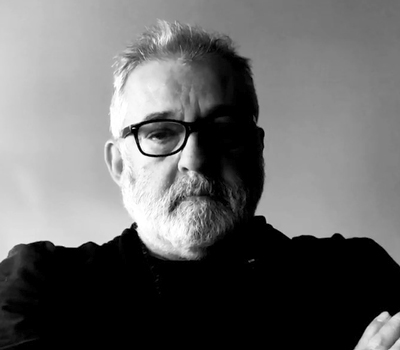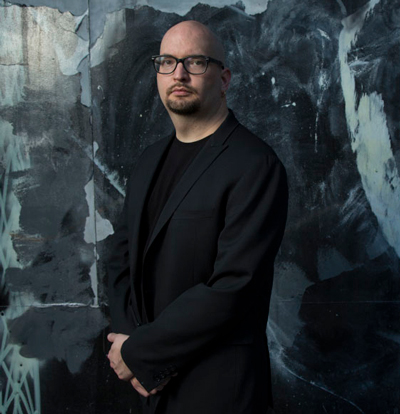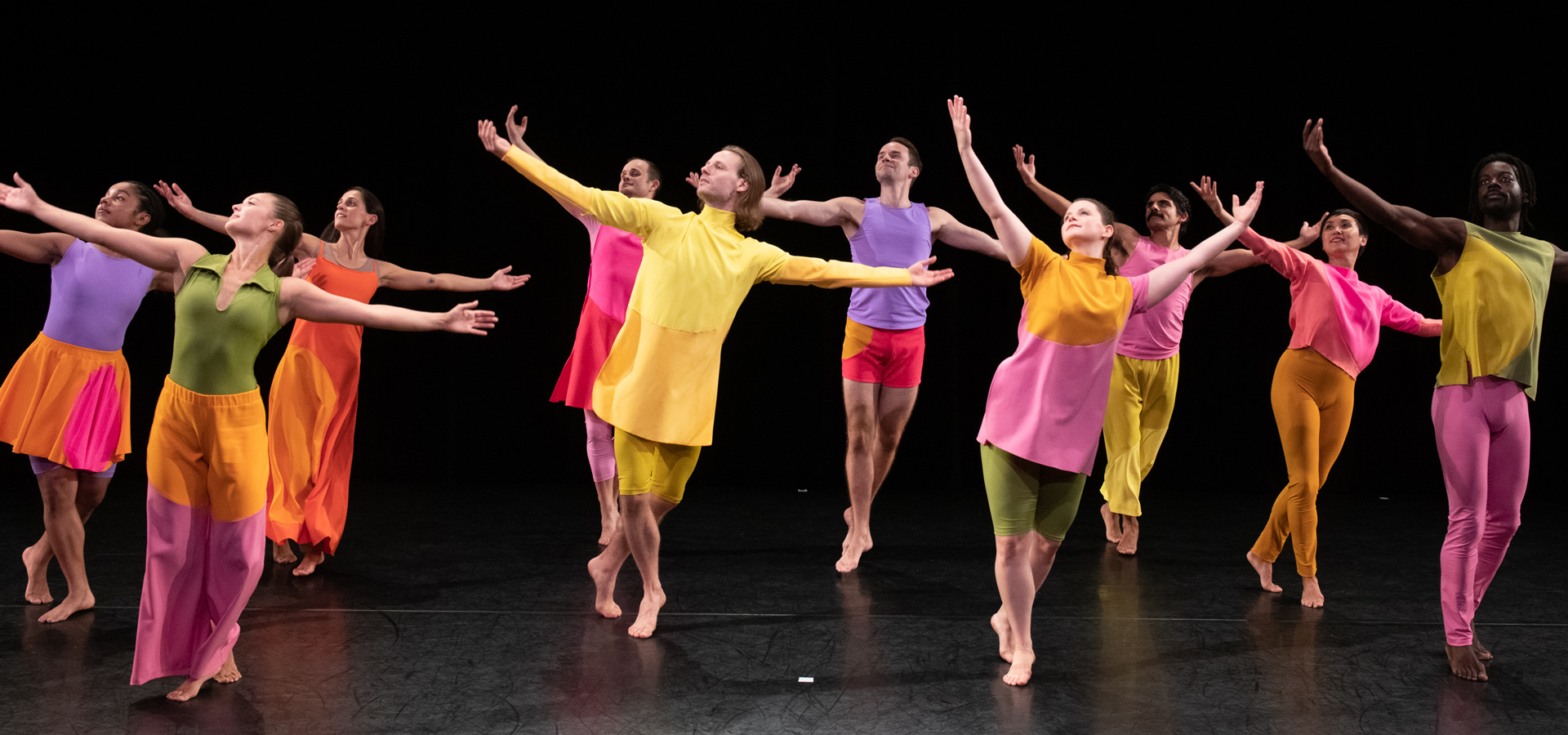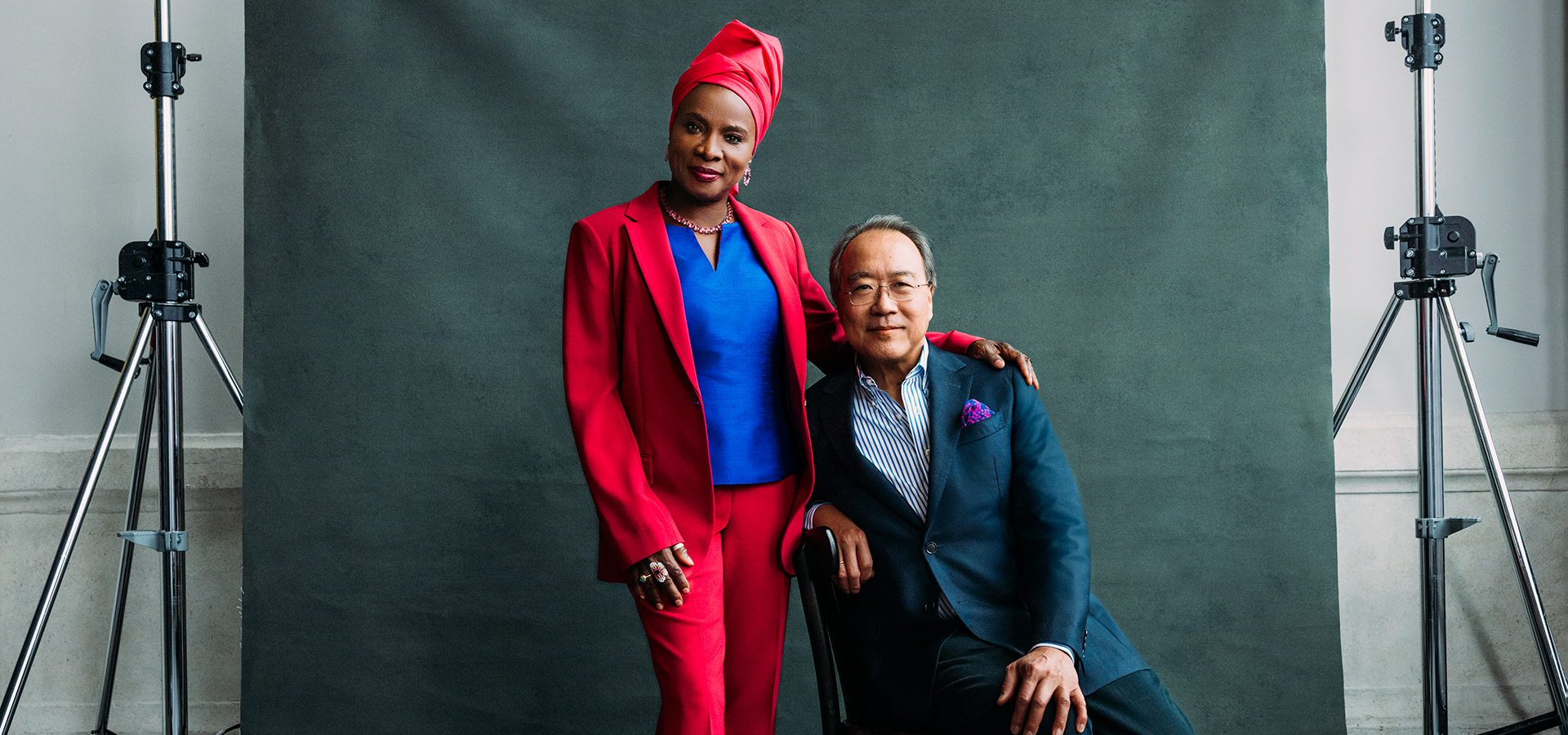
The Making of The Look of Love
Pictured from left to right: lead singer Marcy Harriell, choreographer Mark Morris, and musical director, Ethan Iverson.
Choreography & Music, Creatives & Logistics.
Interview of Mark Morris and Ethan Iverson conducted by Krista Thomas, Cal Performances’ Associate Director of Communications
In February 2023, Mark Morris Dance Group will bring the Bay Area premiere of Morris’ latest work, The Look of Love, to Zellerbach Hall. Notably, this is Morris’ first evening-length work since the creation of Pepperland in 2017, and it marks a return to the world of pop music for the choreographer, celebrating the iconic songs of Burt Bacharach. Take a peek inside the creation of this delightful new production via Q&As with both Morris and musical arranger Ethan Iverson.
MARK MORRIS
 What was the inspiration for creating The Look of Love?
What was the inspiration for creating The Look of Love?
There was no particular spark of inspiration—I always work from the music. In this case, the idea came from Ethan Iverson, who years ago was music director of my company and who remains a brilliant jazz musician, writer, and friend. Long before we did Pepperland together, he wanted me to consider choreographing to Burt Bacharach’s music. Very rarely do I work from what would be considered pop music, but it’s not an anomaly. I love this music and so it came about quite naturally.
What’s your process for creating the choreography?
All of my initial homework is theoretical—I think and I listen to the music, think through the text, in this case, by the astounding Hal David. All of the choreography is made up in a room with the dancers. When the piece is done, the choreography is set, though there’s always an element of improvisation built into the structure. We never perform the exact same show twice.
You collaborate with a number of incredible creators for this work, including Ethan Iverson as arranger, Isaac Mizrahi as costume designer, and Nicole Pearce as lighting designer. What made you want to work with these individuals for The Look of Love, and what has your collaborative process been like?
Often when I start a new dance, Ethan works on the music, though this isn’t a constant since he’s busy with his own projects, but we have done many works together over the years. The same can be said of Nicole and Isaac, who are both brilliant. Once we had the team assembled, it was all conversations and listening to the music. I had some notions already—for example, I knew I wanted chairs and pillows for one scene, which Isaac took over sketching out, proposing different colors and textures…. With costumes, we go back and forth on various sketches. But with both costuming and lighting, one thing to keep in mind is that there are many practical elements—the costumes need to be movable, they need to be able to be laundered or altered quickly while we’re on the road, the lighting needs to be adaptable for different venues. All of these elements are carefully thought out, but none have to necessarily make a huge splash on their own: All things together are magic.
As for the music, Ethan and I don’t think at all alike, which is why we complement each other so well. We started working on this a year-and-change ago and, at the time, Ethan was touring. We’d start working in the studio with commercial recordings, though we also used live music for every rehearsal. As Ethan would send pieces in, we’d revise and tweak elements. There’s one particular sequence where I had us change the tempo to better pair with the choreography, and it really made a big difference.

Mark Morris Dance Group rehearsing The Look of Love
What was it like presenting the idea and later the work itself to Burt Bacharach?
Once we’d decided on this endeavor, Ethan and our team met with Burt and his team. He was very enthusiastic and essentially gave us carte blanche to use the music. He came to the dress rehearsal on the night before the premiere in Santa Monica in late October. He sat and watched the whole thing, Ethan and I both talked to him at length, and we introduced the dancers and musicians to him from a distance (for COVID safety). It was our first time getting through all of the elements so there was still tweaking to do, but he said he liked it! He was super friendly and supportive; to meet him in person was wonderful.
Are there any stylistic elements or themes you’d like audiences to watch for?
The only answer is to pay attention. There’s no prescription for how anyone should respond; everyone experiences the art differently. Sitting for over an hour and focusing on both the music and dance is already difficult, especially with people still not used to being in theaters and crowds.
Regarding themes, The Look of Love isn’t a juke box of pieces, nor is it a sad story of someone finding themselves. And I don’t believe art exists to make us feel better or become better people, because there’s good and bad in everything, and it takes a big variety of elements to make art. The Look of Love is beautiful and moving. It’s also presented directly in its own language, in this case, of music many people will recognize. Above all, it’s entertaining. Sometimes we simply want to have a good time. That doesn’t mean it’s shallow. It is for everybody, made in a personal way everyone can enjoy.
…And now, onto the music!
ETHAN IVERSON
 Mark mentioned that you had often suggested he do a production around Burt Bacharach’s music. What about this music stood out as something he should choreograph to?
Mark mentioned that you had often suggested he do a production around Burt Bacharach’s music. What about this music stood out as something he should choreograph to?
I always loved the way Mark responds to text, meaning lyrics. Of course, many of his biggest successes—like L’Allegro, il Penseroso ed il Moderato and Dido and Aeneas—deal with text, but there’s also something like the magnificent Going Away Party to country and western ballads from Bob Willis. Hal David’s lyrics to Bacharach are phenomenal. Although this is heresy, it was easy for me to imagine certain moves Mark might do to David’s text. Also, Mark is very sophisticated. He reads a musical score well and can work with hard meters and melodies. While some might consider Bacharach a “light” composer, it turns out that, under the hood he is marvelously sophisticated. The songs are intricate but also catchy—which might be the hardest thing to do in music.
When you were creating arrangements for this work, was there a guiding principle for the types of alterations you might make?
Most of the time, I took the Hippocratic oath: “First, do no harm.” In the previous work I arranged for Mark Morris, Pepperland, I was quite severe when creating abstractions of the Beatles. However, with Burt, I was comparatively gentle, meaning the songs are mostly heard without too many alterations. Mainly I added introductions, interludes, and endings, although one or two places do get a bit avant-garde. I believe it is very important to strip it down to the essentials. Many modern-day versions of ‘60s music are all shiny and banal, with lots of boring synthesizers and electronic drum machines. I believe in raw and acoustic music.
Much of the excitement around this piece has to do with the fact that the music is pop and well-known to audiences. Do either of these elements influence the way you arranged for The Look of Love as opposed to something more classical in nature?
The main thing is a drum set. A drum set in the pit changes the music utterly, from something like chamber music to something like rock or jazz. For Pepperland and for The Look of Love, we are lucky to have a great drummer, Vinnie Sperrazza. It is pop but not too pop! (Too pop is unbearable!) Vinnie loves mystery just as much as accessibility, which is just like Mark Morris and myself.
Watch Marcy Harriell and Ethan Iverson rehearsing The Look of Love by Burt Bacharach
What is unique about the way you arrange music specifically for dance?
I admit that I have the advantage of having seen many Mark Morris masterpieces more than once. I watched L’Allegro something like 30 times, and of course when I worked daily for him, I saw how he would put dances together in the studio. Everything I give Mark I am certain he can choreograph, and I have an idea of how the flow of an evening-length work should go.
What was it like to meet and have the piece performed for Bacharach (during a dress rehearsal)?
That was a great moment! Of course, I couldn’t worry about the composer too much—that never works. It wasn’t written to please Burt; it was written to please Mark Morris and myself. But I was very moved when he said he approved of the music and the dance. Blessed by Burt! I can live with that!
Anything else folks should know about The Look of Love?
As with Pepperland, I’m delighted to be part of a big show that offers nothing but joy. (Okay, there’s some heartbreak in there too!) But the message is ultimately really uncomplicated: Love is everything!




